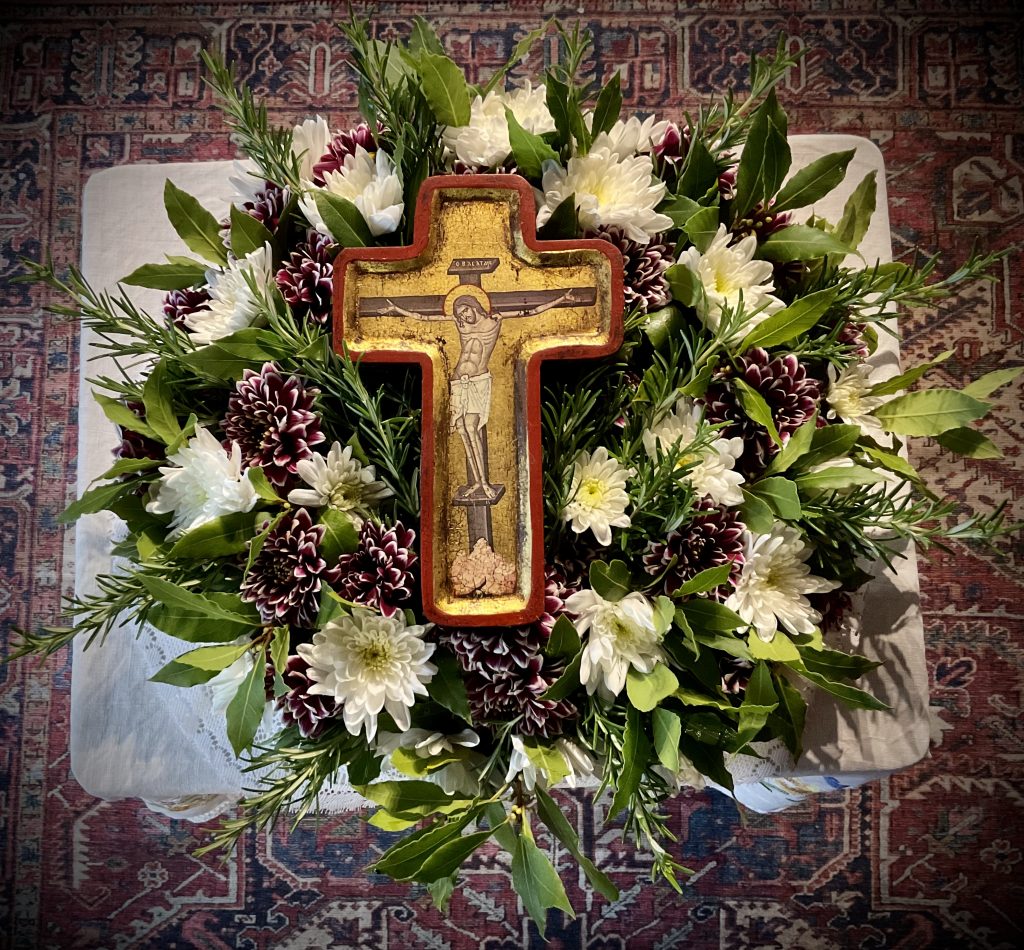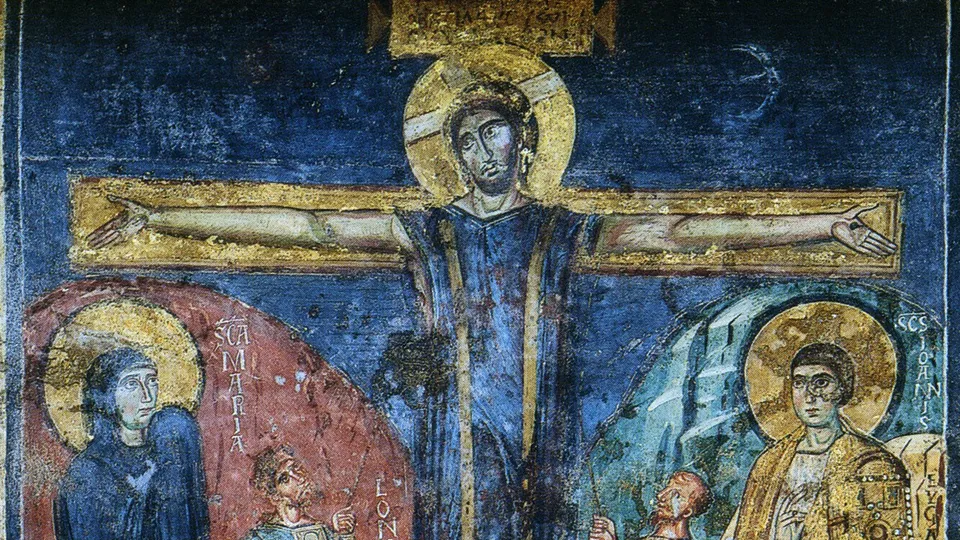“The Cross is the guardian of the whole world! The Cross is the beauty of the Church! The Cross is the strength of kings! The Cross is the support of the faithful! The Cross is the glory of the angels and the wounder of the demons!”
(Exapostilarion)

In the Name of the Father, and of the Son, and of the Holy Spirit.
Dear brothers and sisters,
Greetings for the feast of the Exultation of the Precious and Life-Giving Cross of the Lord.
Contrary to the logic of the world and the mockery of the modern day equivalent of the Jews (for whom the Cross was a stumbling block) and the Greeks (for whom the Cross was foolishness), today, we joyfully celebrate the feast.
In our temples, we surround the Cross with herbs and flowers, venerating it as a precious treasure and source of sanctification, blessing and healing.
Prostrating ourselves and venerating it, we chant, “Before Thy Cross we bow down, O Master, and Thy holy Resurrection we glorify.”
In our cathedrals and monasteries, hierarchs and abbots bless the four corners of the earth, with the Cross as the sign of victory by which the demons are conquered, the powers of evil put to flight, and the world consecrated through God’s grace. We know that the powers of hell fear this very sign and painful reminder of their own defeat and impotence.
But, how can it be that a the Church came to recognise a Roman gibbet, a shameful tool of torture and death to be the sign of victory and the Tree of Life?
The early Christians and Fathers of the Church saw many types of the Cross in the Jewish scriptures: in the wood with which Noah built the salvific ark; in the the wood carried for Isaac’s intended sacrifice; in the rod of Moses, which divided the Red Sea, opening a path from slavery to freedom; in the cruciform raising of Moses arms, by which Israel defeated Amalek; in the bronze serpent set cross-wise on a pole for the healing of the Israelites bitten by the fiery snakes.
In all of these, the meaning and vision was of healing, deliverance, freedom, salvation, victory and restoration.
As inheritors of the early Christian understanding of the prophetic and prefigurative voice of the scriptures in image and symbol, and as heirs of their spiritual approach to the Cross, we celebrate and honour it in its glorious, life-giving fulness.
Like the early Christians, seeing beyond the Saviour’s pain and suffering in His accepting, embracing, carrying and enduring the Cross, we see life, liberation, the restoration of humanity and the redemption of Adam and Eve, and of all humanity with them.
Thus, over twenty centuries after an instrument of torturous death was transformed and consecrated by the Saviour’s sacrificial love, obedience, humility, and His total outpouring of self, we Orthodox Christians hymn and venerate the Life-Giving Cross as the Tree of Life, the destruction of hell and the death of death.
Whilst some heretics are loathe to even acknowledge the reality of the crucifixion and the form of the Cross, we embrace it with enthusiastic devotion and deep love – having been sealed with its precious image in Holy Baptism and Chrismation; wearing it around our necks; being signed with it upon our heads in confession as we are assured of Christ’s forgiveness for the penitent; anointed with its form in Holy Unction; tracing its image upon ourselves in prayer and divine worship, and being blessed with that same figure.
In the hymns of Paschal matins, we boldly declare that “through the Cross, joy hath come to all the world…”, and exulting in this joy, we are mindful that at the heart of the meaning of the Cross is the reckless and limitless love of God, of which the sacrificial-love of the Cross was sign of the absolute nature of that love in which God held His Creation from its very beginning.
Desirous for the redemption and restoration of His children from the very moment of their fall, in that love, in the economy of salvation, He sought to heal like by means of like, entering into creation itself to effect the healing and salvation of the fallen.
Just as sin, disobedience and death entered the world through wood – by the Tree of Knowledge – so righteousness, obedience, and restored life would be effected through the Wood: the Tree of the Cross, which has become for us the Tree of Life.
He Who was raised up on this Tree, of His own will, was the very Immortal Word of God and Creator of Whom St John tells us, “All things were created through Him, and apart from Him not one thing was created that has been created…”
As the first Adam fell through approaching a tree in disobedience, and the fruit of that tree was death, so the second Adam approached His Tree in obedience, and the fruit of that Tree is life!
This is proclaimed by the Church’s hymns for the feast, in which we reflect that the tree was healed by a Tree, chanting in matins,
“Of old, in paradise, a tree stripped me naked, the enemy bringing about mortality through eating; but the Tree of the Cross, bearing for men the vesture of life, hath been planted in the ground, and the whole world hath been filled with all manner of joy.”
From the height of that Tree, Christ, the Wisdom, Word and Power of God created anew: making of humanity and the world a new creation, whose conception is signalled by the words of the sacrificed Lamb of God, “It is done.”
As the earth quaked, the sun was eclipsed, the Veil of the Temple was rent from top to bottom, and the bodies of the saints rose from their graves, the awesome, life-giving and world-changing power of the Cross was first manifested in the labour pains of a new world born and created from the height of the Cross.
Year by year, we celebrate this wonderful mystery in this feast of the Exultation, knowing that those who love the Cross of Christ, embracing its message of sacrificial love, selflessness and obedience in their lives are themselves exalted by the Cross just as much as we exalt the Cross on this joyful feast.
St Ephrem the Syrian poetically speaks of the Cross as a bridge spanning the jaws of death, and leading to ‘the land of the living’:
“He who was also the carpenter’s glorious son set up his Cross above death’s all-consuming jaws, and led the human race into the dwelling place of life. Since a tree had brought about the downfall of mankind, it was upon a tree that mankind crossed over to the realm of life. Bitter was the branch that had once been grafted upon that ancient tree, but sweet the young shoot that has now been grafted in, the shoot in which we are meant to recognise the Lord whom no creature can resist.
We give glory to Thee, O Lord, who raised up Thy Cross to span the jaws of death like a bridge by which souls might pass from the region of the dead to the land of the living. We give glory to Thee who put on the body of a single mortal man and made it the source of life for every other mortal man.”
On this feast, we glorify the Lord and His Life-Giving Cross, by which hell was defeated and stripped bare as the Risen Lord led our first-father and first mother with the saints of the Old Israel across this wondrous bridge from death to life.
In labouring to follow Him, Who wishes to exalt and raise us up by His Cross, let us rejoice and celebrate in the radiant joy of the feast.
“Come then, my brothers and sisters, let us offer our Lord the great and all-embracing sacrifice of our love, pouring out our treasury of hymns and prayers before him who offered his Cross in sacrifice to God for the enrichment of all.”
(St. Ephrem the Syrian, 306-373 AD)
As the Tree of Life, and the sign of selfless cruciform-love, let us live with the Mystery and meaning of the Cross, as the centre of our lives: our axis mundi stretching from earth to heaven.
Amen.
 J
J